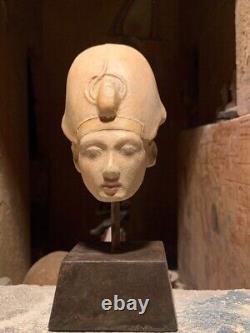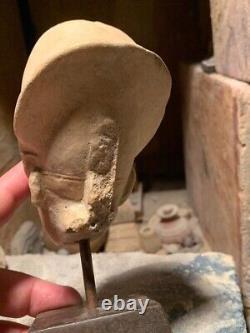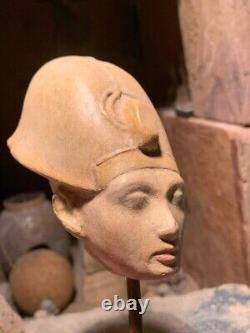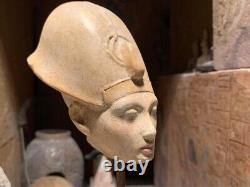Egyptian statue fragment of King Ankheperure Nefertiti Akhenaten








If you're looking for a unique and beautiful piece of art, look no further. The statue is the perfect way to add some flair to any home or office. Total height - 15.2 cm / 6 inches approx. Base stand - 6.3 x 6.3 cm / 2-1/2 x 2-1/2 inches. Made of a limestone and quartzite composition stone, the bust is mounted on a removable felt based stand.
On offer here is an attractive and rare replica of an Amarna period royal statue. The identity has variously been interpreted over the years as Akhenaten, Smenkhare, Tutankhamun or Nefertiti in the role of co-regent.
Recent reappraisal of this bust has now established the great weight of evidence in the favour that it is Ankheperure, a later name associated with Nefertiti in the role of King. Based on style it is from the late Amarna period which lacks the harsh modelling typical of the early years of this revolutionary period in Egyptian art.
The soft features compare well with other images of Nefertiti before the Name change. One must look at the famous unfinished quartzite bust of Nefertiti to see this soft sculptural style in action. The eyes are not carved as in this sculpture and this style is known as'sfmato'.
The eye details were painted on the raised mound of the eye and the remnants of these details can be seen on this replica. A remnant of red on the lips shows us that the statue was once enlivened by the application of full red lips and this is the striking evidence that points to a female ruler in contrast to the masculine crown being worn. The crown - the'Khepresh', was tradtionally worn by male rulers and known also as the so called'blue crown'. It is also known as the'war crown' although war was not on the Agenda at Amarna. The remains of a royal cobra rests on the brow and curls and trails up towards the center of the crown.
The profile of this statue is quite striking. The fact that the remnant red lips have been overlooked is significant.
Red lips are almost exclusively the style trait of female statues and combined with the crown is a statement that a Queen has become king. This statue is not alone. Another even finer statue in the Hannover museum has joined this new category of red lipped statues of the Amarna period. Previously thought to be Akhenaten in the softer style is more likely to be Nefertiti / Ankheperure. We invite you to explore our online store, where you will discover a wide range of meticulously crafted replicas that pay homage to Egypt's cultural heritage.
From awe-inspiring statues and intricately designed jewelry to beautifully crafted furniture and captivating artifacts, our collection offers an immersive journey into the world of ancient Egypt.


